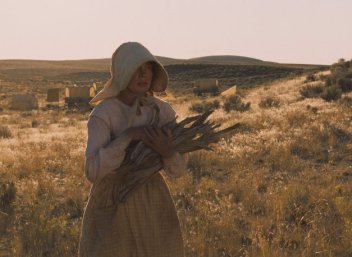Five minutes in, you’re shifting. Folding your arms. Unfolding your arms. Crossing your legs. This armrest. No, that armrest. All the while thinking, Oh no, will this film be this slow for two more hours?
It is commonly the unlucky task of modern filmmakers to entertain first and make art second. Anything less and most of us are fidgety. Our culture of sensory-overload has unfortunately forced some art forms to drill in dramatic tension like a pneumatic device; a shock collar ready to jolt us if we drift away. Which begs the question: why do we expect films to bear the same function as a roller coaster?

The new film Meek’s Cutoff begins with a sequence of three families fording a river with their goods in tow. One after the other, they wade through with their livestock, wagons, birdcages, and everything else. The scene is long, wordless, and utterly enthralling.
The film takes place in 1845, following three families as they tread the beginnings of the Oregon Trail. In their search for a bountiful land on which to settle, they become misguided and lost, trapped in a harsh wilderness.
The film is implacably quiet and slow, and all the more interesting for it. The plot, though loosely outlined, leaves much to the imagination. It is a film more American than most, compiling imagery for a people lost in a quest to achieve their dreams. The family’s search seems futile, and the quiet tone of the film seems sympathetically relevant. The drawn-out, meticulous images sear into the viewer’s brain, serving as metaphors as much as pieces of a story.
It is altogether effective — achieving everything you’d look for in your standard movie-going experience. If juiced up with a big budget, quicker shots, more action, and a love story, the film might be a blockbuster. But, despite its excellence, you probably won’t find it in many theatres. The reason? It’s a minimalist film.
One of the great tools of art is that it helps us slow down and reflect. It’s a rarity in our culture to be able to stand, mouth agape, and take in beauty for long periods of time. Regrettably, our default mode is to say, “Let me comment on the art, not the other way around.” We are eager to judge non-traditional styles, not experience them.

The brand of the minimalist film seems to render the critic useless, as the main thing to criticize is the style itself. Whether this is good or bad is up for debate. But since the minimalist film is very decidedly a contemplative style, you can really only experience it for yourself, creating a valuable objectivity that leaves you more moved than opinionated. One could argue that it is for this visceral mystery that art exists, but when it comes to film, most of us are conditioned to want something speedier and more immediate. Perhaps the reason for our boredom when viewing art is not a justifiable reason to be bored. Perhaps our minds are too frenetic or stubborn to admit our flawed opinions.
Although the argument against our ADD-culture is often too belabored, it’s worth noting that filmmakers have it decidedly worse than most when it comes to finding an audience. Audiences have been trained to expect an explosion here, a gross-out scene there. For the filmmaker, making industry of their art necessitates far too much compromise.
Quiet (or “minimalist”) films deserve a fairer hearing. Especially nowadays. They pair the richness of photography with the power of narrative, giving equal measure to each. They give us a respite from the sensory rush we are accustomed to in everyday life. And not surprisingly, the minimalist film can achieve introspection as much as escapism. We often reserve the term “reflection” for quiet spaces, like gardens or churches, but quiet films can offer an equal sanctuary. Here your mind is fixed on a set of meticulously crafted images, the beauty of which can draw us into empathy or help us see a landscape in a new way.
So, beyond market conditioning, why do we insist on our movie-going experience to coddle our expectations of a traditional story arc with expensive fireworks? We don’t expect Phillip Glass to sound like Wagner, or Pollock to look like Van Gogh. Why do we limit our movie-going choices to the narrowest of margins and the most industrial of styles?

Perhaps we’ve become too quick to criticize, where art urges us to merely be openly affected. Art’s strength is in its power to transcend, to bask in beauty and mystery, to contemplate viscerally and not just normatively. To truly experience these benefits requires a slowing down that most of us are unwilling to brake for, let alone pay the cost of admission for.
In slowing down, we move forward into new territory, allowing the raw materials of the world to shine in a new light. Installation artist Cory Arcangel recently posited in his interview with The New Yorker that, “Isn’t it the whole job of art to let new things in the door?” The quiet film helps us greet new things with the attention they deserve, and not speed by them with a hurried glance or cold shoulder.
Our quality of film as a culture is something to be proud of. But might that reputation dissipate if we are never willing to take the time to recognize what is new? Without slowing down, we might see far more emulation than innovation in the film world. Taking the time to rest and slow down when we enter a movie theater might energize us more than we think.